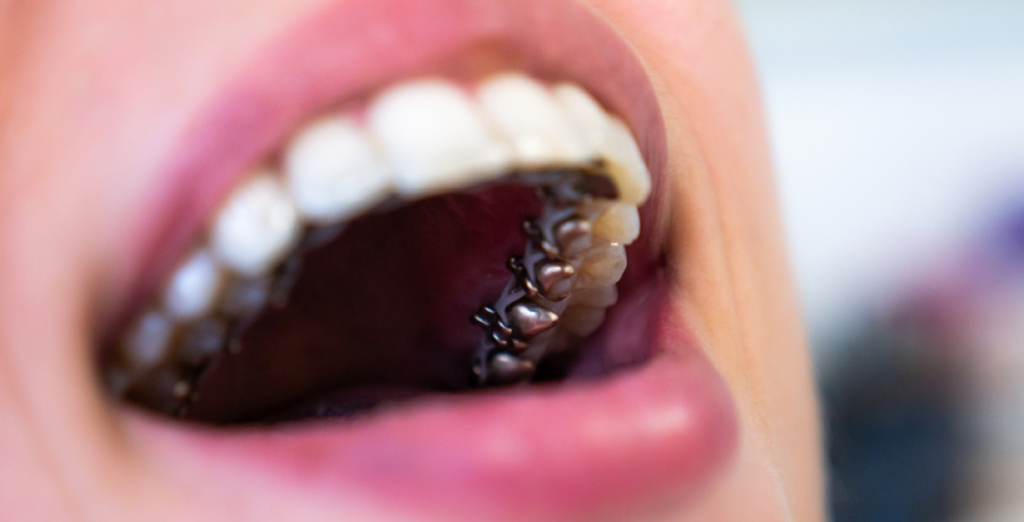This treatment is for you if…
You want to align your teeth rapidly without it being noticed that you are wearing brackets.
What are lingual orthodontics?
Lingual orthodontics is a technique used to align teeth without the brackets placed on the patient’s teeth being seen from the outside. Their functioning is very easy: the brackets are placed on the internal face of the teeth, with the outside of the teeth being completely free.
This type of orthodontics resolves most alignment problems. Generally, it is the alternative chosen by many people that give importance to their image and do not want people to know that they are having orthodontic treatment.
The treatment has a variable duration, although it usually lasts an average of 18 months to two years, with periodic visits to the specialist being required during the treatment.
Types of lingual orthodontics
The types of lingual orthodontics are differentiated by the type of brackets and the trade names. The most usual ones are as follows:

Incognito brackets
They are made to adapt to a certain tooth and are as flat as possible to make them comfortably fit the patient’s teeth. They are made with a gold alloy that reduces the possibilities of suffering any type of allergic reaction.
Self-ligating lingual brackets
This option involves metal wires that are automatically adjusted throughout the whole treatment. They offer a more comfortable satisfying experience to the patient, since they reduce, on a substantial basis, frequent trips to the dentist and the concomitant inconvenience.
Standard lingual orthodontics system
This is a traditional system that is ideal for people that want to make the most of the advantages of lingual orthodontics, but who do not want to spend much money. The brackets have standard characteristics. That is, they are attached to the dental surface of each patient, but they are not personalisable.
Advantages of lingual orthodontics
- Aesthetics. The first advantage of lingual orthodontics is that they are virtually invisible, so they have an aesthetic advantage for those that wear them. Nobody will be able to tell that you are wearing any type of brackets. They do not modify the shape of the teeth or of the face either.
- They are effective. There is no point in lingual orthodontics being aesthetically pleasing if they do not achieve their main objective – that of teeth alignment. In this regard, this technique is fully effective from the first moment and its results begin to be noticed in the first few months. In fact, lingual orthodontics usually act more quickly than traditional brackets.
- Made-to-measure. The brackets are designed in line with the needs and characteristics of the patient’s teeth. They are fully personalised, thereby increasing their effectiveness and comfort.
- They reduce treatment time. Since the brackets are designed expressly for the patient’s teeth. A better settling of the bracket improves the effectiveness and precision of movements and reduces the time needed to correct the problem.
Lingual orthodontics treatment phases
1. Case study. Before beginning the lingual orthodontics treatment, the clinic will carry out a personalised study to assess the current situation of the patient’s teeth and objectives. Hence, it will carry out a series of easy tests through which the specialist may design a precise, personalised treatment for each patient.
2. Information to the patient regarding the treatment details. In the second phase, the patient will be informed clearly regarding the treatment to be followed, together with all its details.
3. Once the patient has accepted the conditions, the active phase of the lingual orthodontics will begin. Its objective is to eliminate or correct dental crowding and vertical discrepancies regarding the fitting of brackets. This phase usually lasts between 18-24 months and, once it has ended, the teeth will be perfectly aligned.
4. Frequent check-ups. They will serve to assess the progress of the orthodontics and to adjust the items to make them more effective. This phase may last between six months and two years.
5. Removal of the brackets, when the objectives determined in phase 1 have been attained, the lingual brackets will be removed.
6. Retention phase. Once the teeth have been perfectly aligned and the orthodontics have been removed, retainers will be placed to ensure that the position of the teeth is perfectly conserved. Normally there is a more intensive stage involving the use of retainers, which normally lasts between three-six months after withdrawing the brackets, after which their use will be maintained on a less intensive basis to avoid the teeth moving. Various types of retainers exist with the made-to-measure nocturnal mouth guards and fixed retainers being the most used.
Prices
The amounts indicated have been estimated in line with a full treatment, in accordance with the parameters in the table. Includes: study, treatment and check-ups during the treatment, so it serves as a guide and is of a merely informative non-contractual nature. The personalised treatment will be examined in line with the medical prescription. Prices can be increased if additional costs are incurred as a result of the requests made by each customer. Price valid until 31 December 2024 except in the event of a typing error.



